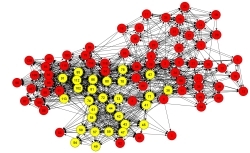



The method (Social Network Analysis) 
Social network analysis is a modern and popular tool to investigate complex, multiple and multi-structure relationships between various social actors. It is rooted in the tradition of many disciplines and tools (e.g., mathematics, sociology, anthropology, statistics, etc.). It responds to the challenges associated with the process of development of the complex structure of a network society (M. Castells) and the formation of a knowledge-based economy. With the development of appropriate software, SNA has become an important research tool used not only in science but also in business, in particular, in advisory services in support of various aspects of management. Special analytical software has become an important catalyst for the development and popularization of the SNA network as well as links to social studies. The following researchers and experts can be mentioned among the major SNA developers and developers: Stanley Wasserman, Steve Borgatti, Philippe Bonacich, Berry Wellman, Linton C. Freeman, Valdis E. Krebs, Mark Granovetter, David Knok and Rob Cross.
The specificity of the SNA consists primarily in a different research perspective, whereby explanatory power lies not in the properties of those surveyed (i.e., their characteristics, attitudes, or descriptions of their behaviour) but mainly in the relations between them. Hence, the subject of research are the relationships that connect the network elements of different types (called nodes). The role of the network nodes can be performed by different social actors, such as individuals, groups, businesses, or even international organizations or countries. The structure of the network can create a wide range of relationships, starting from the simple interpersonal relationships (e.g. friendship, family, etc.), through the economic relationships (e.g. capital ties, cooperation in strategic alliances), ending with the sophisticated political or international affiliations. In addition, the examined relationship may be symmetric (reciprocal) or one-sided Thus it can be concluded that social network analysis is a versatile tool which can be used wherever the relations are the subject of analysis.. Currently, the SNA as a research tool is widely used in social sciences, management, internet or market research.
Due to the fact that relationships are the focus of this research method, the collected data has relational character, which means it belong to the part of network which is linked with the relation. It is therefore significantly different to the typical presentation of the SNA process and analysis data. With this tool, there are two basic ways of presenting data through the array or the matrix diagram generated by a visualization program.
This tool has many features to study properties of the network and interpret the role of the nodes as well as their connecting relationships. It is generally assumed that the SNA network can be analyzed at three main levels:
At the level of the whole network (e.g. number of relationships, network density, the distance between network elements, separation of core and periphery networks, etc.)
• At the level of the individual parts of the network (e.g. to determine the relationship between different groups, indicating the central and isolated groups in the network, identify the bottlenecks between the groups etc.)
At the level of individual network nodes (e.g. indication of the factors that are network integrators, indication of the main dealers, indication of peripheral players etc.)
The results of appropriate software-based social network analysis can also be endorsed by visualizations, which significantly facilitate further interpretation and inference.
Social network analysis is still a relatively new and rapidly developing research tool that fits perfectly into the observed socio-economic change. The increase in popularity of the SNA is associated with the development of analytical software, growing interest on the part of business, as well as with many institutes and organizations working for the development of respective tools, including but not limited to: International Network for Social Network Analysis, Network Roundtable, the Institute for Social Analysis of the Network Economy.
The potential of this method was recognized in 2006 by Gartner, who placed SNA among the tools that will have the greatest impact on the economy over the next decade.
SNA w zarządzaniu projektami
Na stronie dodana została prezentacja multimedialna na temat możliwości wykorzystania analizy sieci społecznych (SNA) w zarządzaniu projektami.
more »
EPISTEME Managers o wykorzystaniu SNA w komunikacji wewnętrznej
EPISTEME Managers zostało zaproszone do projektu „Jak budować relacje z otoczeniem - szkolenia z komunikacji w organizacjach" organizowanym przez PWSZ im. Papieża Jana Pawła II w Białej Podlaskiej.
more »
Prezentacje Episteme na Slideshare
Zapraszamy na nasz profil stworzony na serwisie Slideshare.W tym miejscu możecie Państwo znaleźć nasze prezentacje multimedialne,
more »
Uaktualniona lista imprez poświęconych SNA
Uaktualniona została lista konferencji, seminariów i warsztatów poświęconych analizie sieci społecznych (SNA), które zostały zaplanowane na rok 2009.
more »
